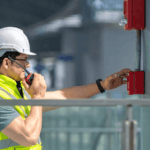
5 Essential Steps for Managing Contractor Safety in Your Workplace
Ensuring the safety of everyone in the workplace is paramount for any organization. But what about those who come and go—contractors? Whether they’re fixing equipment, renovating spaces, or providing specialized services, contractors are integral to many businesses. Yet, their safety can sometimes be overlooked.
That’s why managing contractor safety is crucial. It’s not just about legal compliance; it’s about safeguarding lives and fostering a culture of care. In this blog post, we’ll outline five essential steps every organization should take to prioritize contractor safety effectively. Let’s dive in.
1. Thorough Vetting Processes:
Before engaging contractors, conduct thorough vetting processes to ensure they have the necessary qualifications, certifications, and track record of safety compliance. Verify their insurance coverage and assess their safety protocols to mitigate potential risks.
2. Comprehensive Safety Training:
Provide contractors with comprehensive safety training tailored to the specific hazards they may encounter on-site. Ensure they understand emergency procedures, hazard communication, and proper use of personal protective equipment (PPE) to minimize accidents and injuries.
3. Provision of Necessary Equipment:
Equip contractors with the necessary tools, machinery, and PPE required to perform their tasks safely. Regularly inspect and maintain equipment to ensure it remains in optimal working condition, reducing the risk of accidents due to equipment failure.
4. Ongoing Monitoring:
Implement systems for ongoing monitoring of contractor activities and safety performance. Regularly assess their adherence to safety protocols, identify potential hazards, and address any safety concerns promptly to maintain a safe working environment for all.
5. Effective Communication Protocols:
Establish clear and effective communication protocols to facilitate collaboration between contractors, employees, and management regarding safety issues. Encourage open dialogue, prompt reporting of hazards, and swift resolution of safety concerns to prevent accidents and promote a culture of safety across the organization.
By implementing these essential steps, organizations can not only meet regulatory requirements but also demonstrate a genuine commitment to the safety and well-being of all individuals involved in their operations.
Ben Johnson is a dedicated Customer Success Executive at Safetymint. With a strong commitment to excellence, Ben works closely with customers to ensure they fully leverage the capabilities of Safetymint to its fullest potential, aiming to significantly reduce or mitigate safety risks and incidents.



